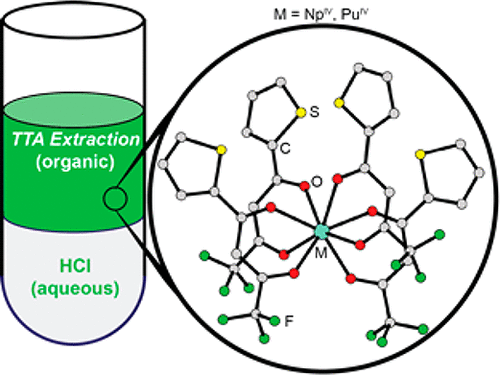当前位置:
X-MOL 学术
›
Inorg. Chem.
›
论文详情
Our official English website, www.x-mol.net, welcomes your
feedback! (Note: you will need to create a separate account there.)
Advancing Understanding of the +4 Metal Extractant Thenoyltrifluoroacetonate (TTA–); Synthesis and Structure of MIVTTA4 (MIV = Zr, Hf, Ce, Th, U, Np, Pu) and MIII(TTA)4– (MIII = Ce, Nd, Sm, Yb)
Inorganic Chemistry ( IF 4.3 ) Pub Date : 2018-03-21 00:00:00 , DOI: 10.1021/acs.inorgchem.7b03089 Samantha K. Cary 1 , Maksim Livshits 2 , Justin N. Cross 1 , Maryline G. Ferrier 1 , Veronika Mocko 1 , Benjamin W. Stein 1 , Stosh A. Kozimor 1 , Brian L. Scott 1 , Jeffrey J. Rack 2
Inorganic Chemistry ( IF 4.3 ) Pub Date : 2018-03-21 00:00:00 , DOI: 10.1021/acs.inorgchem.7b03089 Samantha K. Cary 1 , Maksim Livshits 2 , Justin N. Cross 1 , Maryline G. Ferrier 1 , Veronika Mocko 1 , Benjamin W. Stein 1 , Stosh A. Kozimor 1 , Brian L. Scott 1 , Jeffrey J. Rack 2
Affiliation

|
Thenoyltrifluoroacetone (HTTA)-based extractions represent popular methods for separating microscopic amounts of transuranic actinides (i.e., Np and Pu) from macroscopic actinide matrixes (e.g. bulk uranium). It is well-established that this procedure enables +4 actinides to be selectively removed from +3, + 5, and +6 f-elements. However, even highly skilled and well-trained researchers find this process complicated and (at times) unpredictable. It is difficult to improve the HTTA extraction—or find alternatives—because little is understood about why this separation works. Even the identities of the extracted species are unknown. In addressing this knowledge gap, we report here advances in fundamental understanding of the HTTA-based extraction. This effort included comparatively evaluating HTTA complexation with +4 and +3 metals (MIV = Zr, Hf, Ce, Th, U, Np, and Pu vs MIII = Ce, Nd, Sm, and Yb). We observed +4 metals formed neutral complexes of the general formula MIV(TTA)4. Meanwhile, +3 metals formed anionic MIII(TTA)4– species. Characterization of these M(TTA)4x– (x = 0, 1) compounds by UV–vis–NIR, IR, 1H and 19F NMR, single-crystal X-ray diffraction, and X-ray absorption spectroscopy (both near-edge and extended fine structure) was critical for determining that NpIV(TTA)4 and PuIV(TTA)4 were the primary species extracted by HTTA. Furthermore, this information lays the foundation to begin developing and understanding of why the HTTA extraction works so well. The data suggest that the solubility differences between MIV(TTA)4 and MIII(TTA)4– are likely a major contributor to the selectivity of HTTA extractions for +4 cations over +3 metals. Moreover, these results will enable future studies focused on explaining HTTA extractions preference for +4 cations, which increases from Np IV to PuIV, HfIV, and ZrIV.
中文翻译:

增进对+4金属萃取剂Thenoyltrifluoroacetonate(TTA –)的理解;M IV TTA 4(M IV = Zr,Hf,Ce,Th,U,Np,Pu)和M III(TTA)4 –(M III = Ce,Nd,Sm,Yb)的合成和结构
Thenoyltrifluoroacetone(HTTA)系提取表示用于分离流行的方法微镜下量从超铀锕系元素(即,镎和钚)的宏可视的act系元素基质(例如大块铀)。公认的是,该程序能够从+ 3,+ 5和+6 f元素中选择性除去+4 act系元素。但是,即使是技术娴熟且训练有素的研究人员也会发现此过程很复杂,并且(有时)不可预测。很难提高HTTA的提取率或寻找替代方法,因为对这种分离为何有效的了解很少。甚至所提取物种的身份也是未知的。为了解决这一知识鸿沟,我们在此报告对基于HTTA的提取的基本理解方面的进展。这项工作包括比较评估HTTA与+4和+3金属的配位情况(M IV = Zr,Hf,Ce,Th,U,Np和Pu与M III= Ce,Nd,Sm和Yb)。我们观察到+4种金属形成了通式M IV(TTA)4的中性络合物。同时,+ 3种金属形成了阴离子M III(TTA)4 –物种。通过UV-vis-NIR,IR,1 H和19 F NMR,单晶X射线衍射和X射线吸收光谱法对这些M(TTA)4 x –(x = 0,1)化合物进行表征近边缘和扩展的精细结构)对于确定Np IV(TTA)4和Pu IV(TTA)4至关重要是HTTA提取的主要物种。此外,这些信息为开始开发和了解HTTA提取为何如此有效的基础奠定了基础。数据表明,M IV(TTA)4和M III(TTA)4 –之间的溶解度差异可能是HTTA萃取物对+3金属上+4阳离子的选择性的主要贡献者。此外,这些结果将使未来的研究能够集中于解释HTTA提取对+4阳离子的偏爱,后者从Np IV增加到Pu IV,Hf IV和Zr IV。
更新日期:2018-03-21
中文翻译:

增进对+4金属萃取剂Thenoyltrifluoroacetonate(TTA –)的理解;M IV TTA 4(M IV = Zr,Hf,Ce,Th,U,Np,Pu)和M III(TTA)4 –(M III = Ce,Nd,Sm,Yb)的合成和结构
Thenoyltrifluoroacetone(HTTA)系提取表示用于分离流行的方法微镜下量从超铀锕系元素(即,镎和钚)的宏可视的act系元素基质(例如大块铀)。公认的是,该程序能够从+ 3,+ 5和+6 f元素中选择性除去+4 act系元素。但是,即使是技术娴熟且训练有素的研究人员也会发现此过程很复杂,并且(有时)不可预测。很难提高HTTA的提取率或寻找替代方法,因为对这种分离为何有效的了解很少。甚至所提取物种的身份也是未知的。为了解决这一知识鸿沟,我们在此报告对基于HTTA的提取的基本理解方面的进展。这项工作包括比较评估HTTA与+4和+3金属的配位情况(M IV = Zr,Hf,Ce,Th,U,Np和Pu与M III= Ce,Nd,Sm和Yb)。我们观察到+4种金属形成了通式M IV(TTA)4的中性络合物。同时,+ 3种金属形成了阴离子M III(TTA)4 –物种。通过UV-vis-NIR,IR,1 H和19 F NMR,单晶X射线衍射和X射线吸收光谱法对这些M(TTA)4 x –(x = 0,1)化合物进行表征近边缘和扩展的精细结构)对于确定Np IV(TTA)4和Pu IV(TTA)4至关重要是HTTA提取的主要物种。此外,这些信息为开始开发和了解HTTA提取为何如此有效的基础奠定了基础。数据表明,M IV(TTA)4和M III(TTA)4 –之间的溶解度差异可能是HTTA萃取物对+3金属上+4阳离子的选择性的主要贡献者。此外,这些结果将使未来的研究能够集中于解释HTTA提取对+4阳离子的偏爱,后者从Np IV增加到Pu IV,Hf IV和Zr IV。

































 京公网安备 11010802027423号
京公网安备 11010802027423号